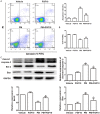Fibroblast growth factor 10 protects against particulate matter-induced airway inflammatory response through regulating inflammatory signaling and apoptosis
- PMID: 31814901
- PMCID: PMC6895507
Fibroblast growth factor 10 protects against particulate matter-induced airway inflammatory response through regulating inflammatory signaling and apoptosis
Abstract
Chronic respiratory disorders are some of the most frequent and severe chronic diseases in China. Epidemiological research has shown that particulate matter (PM) is a risk factor and is closely correlated to the progression of numerous respiratory diseases. Fibroblast growth factor 10 (FGF10) is a mesenchymal-epithelial signaling messenger essential for the development and environmental stability of several tissues. Nevertheless, its role in PM-induced airway inflammation remains unclear. The present study aimed to explore the mechanisms underlying the FGF10-related slowing of lung injury and inflammation in vivo and in vitro, as well as the therapeutic potential of these phenomena. Mice were intraperitoneally injected with a vehicle (PBS) or FGF10 (0.5 mg/kg) at one hour before intratracheal treatment with vehicle (PBS) or PM (4 mg/kg) for two consecutive days. Human airway epithelial BEAS-2B cells were exposed to a vehicle (PBS) or FGF10 (10 ng/ml) in vitro at one hour prior to incubation with a vehicle or PM (200 ug/ml) for 24 hours. Then, the impact on inflammatory molecules was investigated. In vivo, it was found that FGF10 diminished the inflammatory cell aggregation and reduced the apoptosis. Interestingly, in the PM group, the level of FGF10 increased in the bronchoalveolar lavage fluid (BALF). However, the pre-treatment with FGF10 markedly impaired the PM-induced increase in IL-6, IL-8, TNF-α and PGE2 levels in BALF and the cell supernatant. In conclusion, the present findings indicate that FGF10 attenuates PM-induced airway inflammation by inhibiting apoptosis and inflammation. This may be exploited for the prevention and management of PM-induced airway inflammation.
Keywords: Airway inflammation; apoptosis; chronic respiratory disorders (CRD); fibroblast growth factor 10 (FGF10); particulate matter.
AJTR Copyright © 2019.
Conflict of interest statement
None.
Figures






Similar articles
-
FGF10 mediates protective anti-oxidative effects in particulate matter-induced lung injury through Nrf2 and NF-κB signaling.Ann Transl Med. 2022 Nov;10(22):1203. doi: 10.21037/atm-22-4389. Ann Transl Med. 2022. PMID: 36544647 Free PMC article.
-
Fibroblast growth factor 10 alleviates particulate matter-induced lung injury by inhibiting the HMGB1-TLR4 pathway.Aging (Albany NY). 2020 Jan 20;12(2):1186-1200. doi: 10.18632/aging.102676. Epub 2020 Jan 20. Aging (Albany NY). 2020. PMID: 31958320 Free PMC article.
-
FGF10 protects against particulate matter (PM)-induced lung injury via regulation of endoplasmic reticulum stress.Int Immunopharmacol. 2022 Apr;105:108552. doi: 10.1016/j.intimp.2022.108552. Epub 2022 Feb 2. Int Immunopharmacol. 2022. PMID: 35114441
-
Cross-Talk Between Inflammation and Fibroblast Growth Factor 10 During Organogenesis and Pathogenesis: Lessons Learnt From the Lung and Other Organs.Front Cell Dev Biol. 2021 May 31;9:656883. doi: 10.3389/fcell.2021.656883. eCollection 2021. Front Cell Dev Biol. 2021. PMID: 34136479 Free PMC article. Review.
-
FGF10 and Human Lung Disease Across the Life Spectrum.Front Genet. 2018 Oct 31;9:517. doi: 10.3389/fgene.2018.00517. eCollection 2018. Front Genet. 2018. PMID: 30429870 Free PMC article. Review.
Cited by
-
Bronchial Variation: Anatomical Abnormality May Predispose Chronic Obstructive Pulmonary Disease.Int J Chron Obstruct Pulmon Dis. 2021 Feb 23;16:423-431. doi: 10.2147/COPD.S297777. eCollection 2021. Int J Chron Obstruct Pulmon Dis. 2021. PMID: 33654392 Free PMC article. Review.
-
Ruscogenin attenuates particulate matter-induced acute lung injury in mice via protecting pulmonary endothelial barrier and inhibiting TLR4 signaling pathway.Acta Pharmacol Sin. 2021 May;42(5):726-734. doi: 10.1038/s41401-020-00502-6. Epub 2020 Aug 27. Acta Pharmacol Sin. 2021. PMID: 32855531 Free PMC article.
-
Roles of the fibroblast growth factor signal transduction system in tissue injury repair.Burns Trauma. 2022 Mar 23;10:tkac005. doi: 10.1093/burnst/tkac005. eCollection 2022. Burns Trauma. 2022. PMID: 35350443 Free PMC article. Review.
-
rhKGF-2 Attenuates Smoke Inhalation Lung Injury of Rats via Activating PI3K/Akt/Nrf2 and Repressing FoxO1-NLRP3 Inflammasome.Front Pharmacol. 2021 Jul 22;12:641308. doi: 10.3389/fphar.2021.641308. eCollection 2021. Front Pharmacol. 2021. PMID: 34366838 Free PMC article.
-
New developments in the biology of fibroblast growth factors.WIREs Mech Dis. 2022 Jul;14(4):e1549. doi: 10.1002/wsbm.1549. Epub 2022 Feb 9. WIREs Mech Dis. 2022. PMID: 35142107 Free PMC article. Review.
References
-
- Wang C, Xu J, Yang L, Xu Y, Zhang X, Bai C, Kang J, Ran P, Shen H, Wen F. Prevalence and risk factors of chronic obstructive pulmonary disease in China (the China Pulmonary Health [CPH] study): a national cross-sectional study. Lancet. 2018;391:1706–1717. - PubMed
-
- Lin J, Wang W, Zhou X, Wang C, Huang M, Cai S, Chen P, Lin Q, Zhou J, Gu Y. The level of asthma control in China from a national asthma control survey. Chin J Tuberc Respir Dis. 2017;40:494–498. - PubMed
-
- Shi J, Chen R, Yang C, Lin Z, Cai J, Xia Y, Wang C, Li H, Johnson N, Xu X. Association between fine particulate matter chemical constituents and airway inflammation: a panel study among healthy adults in China. Environ Res. 2016;150:264–268. - PubMed
LinkOut - more resources
Full Text Sources
